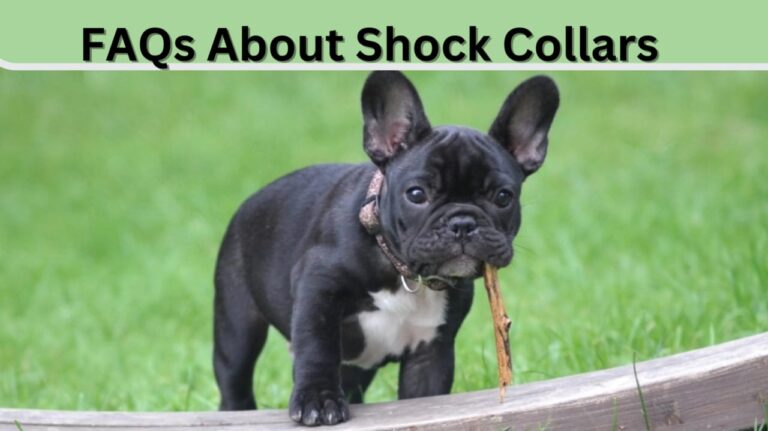Shock Collars Guide: Can you use a shock collar on a puppy?

Can you use a shock collar on a puppy?
When it comes to training puppies, ensuring their well-being and happiness should be a top priority. In the world of dog training, shock collars have been a topic of debate for many years. In this comprehensive guide, we’ll delve deeply into shock collars, exploring their mechanics, pros and cons, and whether they are suitable for training puppies.
Using a shock collar on a puppy is a topic that raises concerns among dog owners. Many people often have this question in their minds, “Can you use a shock collar on a puppy?” so let’s find out the answer. Shock collars, also known as electronic collars or e-collars, deliver an electric shock to the dog when activated by a remote control. While some people believe they can be effective in training, especially for adult dogs, they are generally not recommended for puppies.
Can you use a shock collar on a puppy? A Complete Guide
Many experts advise against using shock collars on puppies under six months old. Puppies are more sensitive than adult dogs, and the shock can have a lasting negative impact on their behavior and well-being. It’s important to prioritize positive training methods that build trust and a positive relationship between you and your puppy.
When it comes to puppies and shock collars, it’s essential to consider their age and development. Puppies are young and delicate, both physically and emotionally. Their minds are still developing, and they may not fully comprehend why they’re receiving a shock. This confusion can lead to fear, anxiety, and even aggression in puppies.
Instead of shock collars, consider using positive reinforcement techniques like treats, praise, and toys to encourage good behavior in your puppy. These methods are gentler, more effective, and create a happier learning environment for your furry friend. Remember, a well-trained and happy puppy is the goal, and positive training methods can help you achieve it.
The Basics of Shock Collars
What Is a Shock Collar?
A shock collar, also known as an electronic or e-collar, is a device designed to deliver an electric shock to the dog wearing it. These shocks can be controlled by a remote and can vary in intensity. The primary purpose of shock collars is to correct undesirable behavior or reinforce commands.
How Do Shock Collars Work?
Shock collars operate by sending an electric shock to the dog when the trainer activates it using a remote control. The idea behind using such collars is to associate the shock with unwanted behavior, such as excessive barking or not following commands.
Pros and Cons of Shock Collars
Pros:
Effectiveness: In certain situations, shock collars can be effective in correcting behavior.
Remote Control: Trainers have the ability to remotely correct behavior, which can be helpful.
Cons:
Potential Harm: Shock collars can cause physical and emotional harm to dogs.
Behavioral Issues: They may not address the root cause of the behavior problem.
Misunderstanding: Dogs may not always understand why they are receiving a shock.
Puppies and Training
Why Puppy Training Matters
Puppy training is a critical aspect of responsible pet ownership. It lays the foundation for a well-behaved and happy adult dog. Proper training helps puppies learn good behavior, develop social skills, and build a strong bond with their owners.
Positive Training vs. Shock Collars
Positive training methods are considered more effective and humane for puppies. These methods focus on rewarding good behavior with treats, praise, or toys, creating a positive association with training. Positive reinforcement builds trust and strengthens the bond between the puppy and the owner.
Age and Development Considerations
Puppies are not miniature adults; they are still growing and developing, both physically and emotionally. This means that they may not understand the purpose of the shock, which could lead to confusion and trauma.
Using Shock Collars on Puppies
Age Restrictions
Many experts advise against using shock collars on puppies under six months old. Puppies are more sensitive and may not respond well to the shocks. Their bodies and minds are still maturing, and the use of shock collars at a young age can have lasting negative effects.
Size and Breed Factors
The size and breed of a puppy play a significant role in determining whether shock collars are suitable. Smaller and more sensitive breeds may be more negatively affected by shock collars. It’s crucial to consider your puppy’s individual characteristics when making a training decision.
Professional Guidance
Before considering the use of a shock collar on a puppy, it’s essential to consult with a professional dog trainer or veterinarian. They can provide expert advice tailored to your puppy’s unique needs and help you make an informed decision regarding training methods.
Risks and Concerns
Potential Harm to Puppies
Shock collars can cause physical and emotional harm to puppies. The electric shocks can lead to anxiety, fear, and aggression. Puppies may associate the pain with the presence of their owner or other dogs, damaging the relationship.
Behavioral and Emotional Impact
Shocks can create a negative association with training, making it harder to teach your puppy effectively. This negative impact can lead to long-term behavioral problems and even more challenges in the future.
Alternatives to Shock Collars
Thankfully, there are numerous positive and effective training methods available for puppies. These alternatives focus on building trust and cooperation between the puppy and the owner. Some popular methods include clicker training, rewards-based training, and enrolling in obedience classes.
Proper Training Techniques
Positive Reinforcement
Positive reinforcement involves rewarding your puppy for good behavior. This can be done with treats, toys, praise, or a combination of these. Positive reinforcement creates a positive association with training and encourages your puppy to repeat desired behaviors.
Obedience Training Tips
Effective puppy training requires consistency, patience, and short, frequent training sessions. It’s important to be gentle and understanding of your puppy’s learning curve. Keep training sessions enjoyable and end on a positive note to keep your puppy engaged and motivated.
Socialization and Consistency
Socializing your puppy is crucial for their development. Expose them to various environments, people, and animals to build their confidence and adaptability. Consistency in training methods and expectations is also vital for successful puppy training.
Choosing the Right Training Method
Evaluating Your Puppy’s Needs
When deciding on a training method, consider your puppy’s age, breed, temperament, and specific training goals. Each puppy is unique, and what works for one may not work for another.
Consulting a Professional
Don’t hesitate to seek guidance from a professional dog trainer or veterinarian. They can provide expert insights into the best training approach for your puppy’s needs, taking into account their individual characteristics and behavior.
When Can you use a shock collar on a puppy?
Generally, it is not advisable to use a shock collar on a puppy, especially if they are younger than six months old. Puppies are still in their developmental stages, both physically and emotionally. Their minds are like sponges, and they may not fully understand the purpose of the shock. This lack of understanding can lead to confusion and even emotional distress for the puppy. It’s crucial to prioritize their well-being and use training methods that are gentle and positive.
In some cases, with guidance from a professional dog trainer or veterinarian, shock collars may be considered for older puppies, typically around six months or older. However, even in these cases, it’s essential to exercise extreme caution, use the lowest possible intensity, and ensure the collar is properly fitted to avoid causing harm or fear. Positive reinforcement techniques, such as treats, praise, and toys, are generally more effective and safer for training puppies, helping them grow into well-adjusted and happy adult dogs.
Is it good to train a puppy with a shock collar?
Using a shock collar to train a puppy is generally not considered good practice for several reasons:
- Puppies Are Sensitive: Puppies are young and sensitive both physically and emotionally. The shock from a collar can be distressing and confusing for them, potentially leading to anxiety and fear.
- Risk of Harm: Shock collars, if misused or set too high, can cause physical harm to a puppy. Their small size makes them more vulnerable to the effects of electric shocks.
- Potential for Misunderstanding: Puppies may not associate the shock with their behavior, which can result in confusion and ineffective training.
- Positive Alternatives: Positive reinforcement methods, such as treats, praise, and toys, are more effective and humane ways to train puppies. These methods build trust and strengthen the bond between the puppy and the owner.
- Professional Guidance: If you are considering using a shock collar, it’s crucial to seek guidance from a professional dog trainer or veterinarian to ensure it is used safely and appropriately. However, even then, many experts recommend avoiding shock collars altogether when training puppies.
In summary, the well-being and happiness of your puppy should always be a top priority, and it’s generally best to opt for positive and humane training methods that create a positive learning environment while ensuring your puppy’s emotional and physical well-being.
Conclusion
In conclusion, the well-being and happiness of your puppy should always be your top priority, especially when considering the use of shock collars. The question remains: Can you use a shock collar on a puppy? While shock collars may work for some dogs in specific situations, they should be approached with caution, especially when it comes to puppies.
Instead, prioritize positive and humane training methods to build a strong and loving bond with your furry friend while ensuring their well-being and happiness. By focusing on positive reinforcement, proper socialization, and seeking professional guidance when needed, you can set your puppy on the path to becoming a well-adjusted and well-behaved adult dog. Remember, your puppy looks to you for guidance and care, so make responsible and compassionate training choices to ensure their best possible start in life.
You may also like this: What Age Can You Use A Bark Collar On A Dog?





